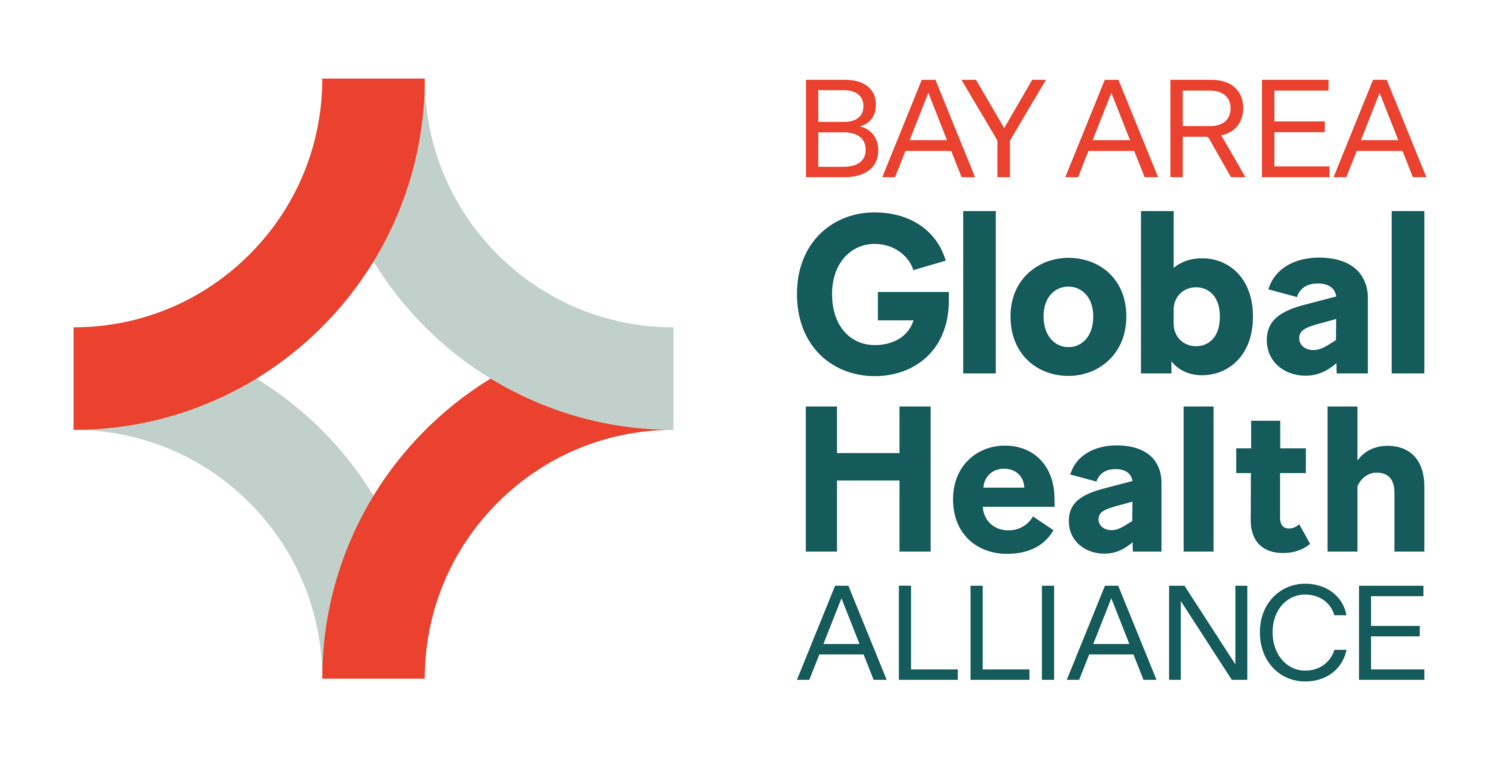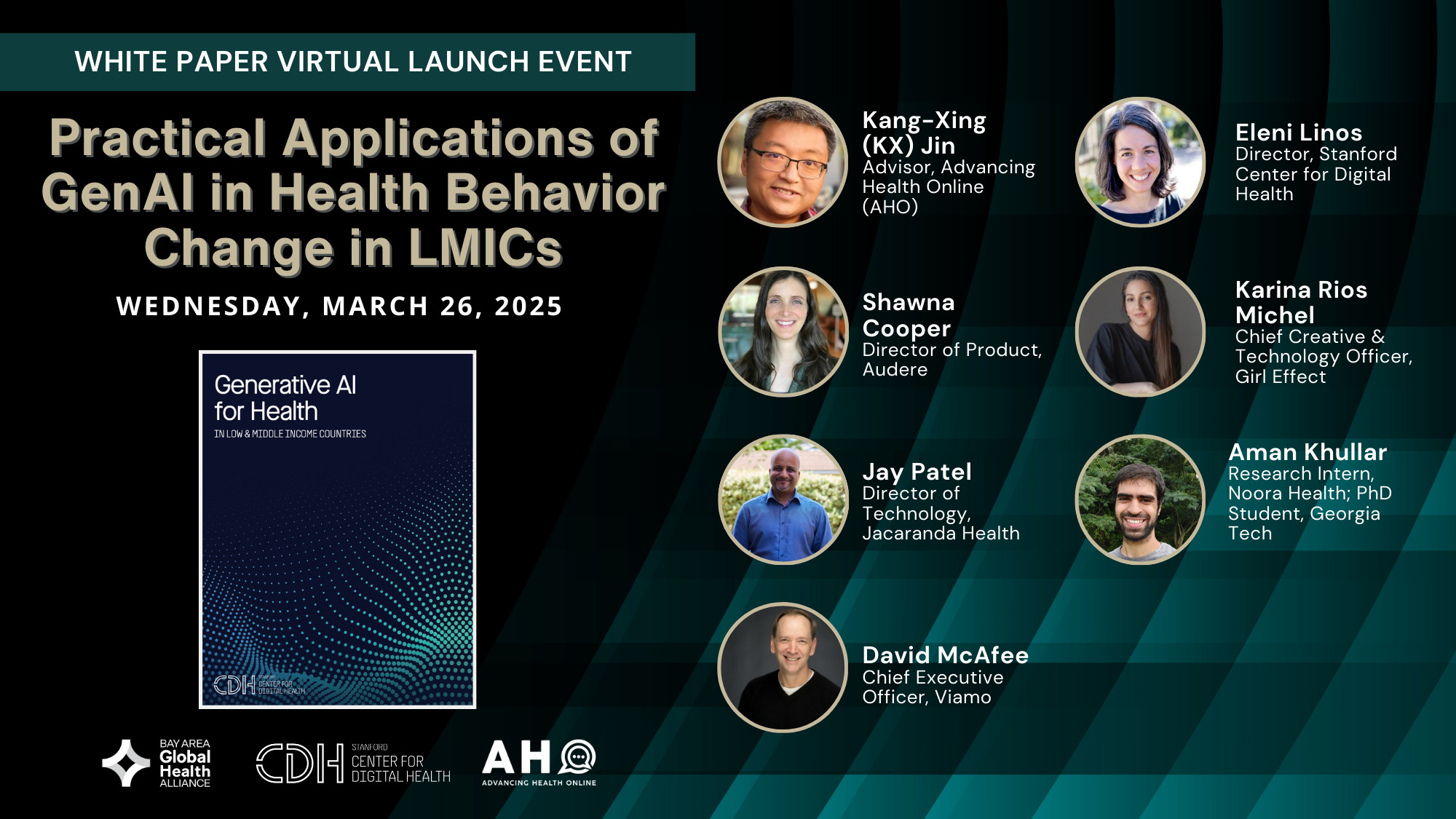Watch the recording here.
View and download the white paper here.
Check out our AI and Global Health Discussion Series for more on AI for health.
On March 26, the Bay Area Global Health Alliance hosted a virtual launch event for the recently released white paper, Generative AI for Health in Low and Middle-Income Countries, showcasing research conducted by Stanford Center for Digital Health (CDH), with support from Advancing Health Online (AHO). The report examines how generative AI (GenAI) is shaping healthcare in resource-limited settings, the greatest successes to date, and the barriers that must be addressed to realize its full potential.
From August to December 2024, the research team conducted an extensive review including two roundtable events, in-depth interviews with people actively working in the GenAI for health space, and a quantitative survey with over 100 respondents. The team additionally reviewed 14 GenAI accelerator programs for health that have collectively supported over 250 projects worldwide.
“To unlock the full potential of generative AI in healthcare for low and middle income countries, we must bridge technical innovation with local realities. This means sharing knowledge, building inclusive infrastructure and creating systems that learn and evolve with communities. The true measure of success is not just technological advancement, but the lives we improve and the health disparities we reduce through thoughtful, collaborative action.” – Fei-Fei Li, Founding Co-Director of Stanford Human-Centered AI Institute
The discussion explored the five key findings from the research: 1) sharing learnings, 2) focusing on actionable measurement, 3) improving language and localization, 4) improving technical capacity and shared infrastructure, and 5) improving digital and basic health infrastructure.
Key Takeaways:
- Cross-sector collaboration is essential: Public, private, and academic sectors must work together to adapt GenAI to local health systems, ensuring expertise is leveraged effectively.
- Localization and accessibility drive impact: AI solutions must be designed for low-resource settings, incorporating local languages, voice interfaces, and offline functionality to reach underserved populations.
- Data quality, awareness of bias, and governance must improve: Enhancing local data collection, training AI on diverse datasets, reducing bias, and establishing clear, robust policies and evaluation frameworks are necessary to ensure GenAI tools are accurate, equitable, and effective.
- Building trust and community engagement are critical: AI adoption depends on transparency, cultural sensitivity, and participatory design, ensuring solutions align with real-world health needs.
- GenAI must enhance, not replace, healthcare systems: AI should enhance healthcare delivery by supporting health workers in diagnostics, education, and triage; investment in strengthening local technical training and infrastructure is important to ensure sustainable, long-term impact.
Goals and Methodology of the Research
Kang-Xing (KX) Jin, advisor for AHO, emphasized the importance of cross-sector collaboration in leveraging GenAI for global health. “Harnessing technological change effectively requires new ways of working across the public and private sectors, funders, implementers, and academia, drawing on the unique expertise of each,” he noted. He underscored the need to reflect on lessons learned from past investments in GenAI to inform future funding decisions and build capacity for those implementing these technologies, which served as the driving force behind this research.
The mixed-methods research analyzed 250+ projects funded by over 10 different organizations, as well as conducted surveys, in-depth interviews, and expert workshops held in Stanford and Nairobi. “The analysis found that the most commonly funded areas were health systems strengthening, sexual and reproductive health, and maternal and newborn health,” shared Dr. Eleni Linos, director of Stanford CDH and principal investigator of the research. Stakeholders identified communicable diseases and maternal and newborn health as top priorities for GenAI applications, with workforce capacity, training, and technical infrastructure seen as critical to success.
Linos also pointed to major barriers identified, noting, “Perhaps the most interesting findings are the key barriers to using GenAI in healthcare settings in low- and middle-income countries, including language limitations in large language models, lack of digital infrastructure, device and internet access issues, AI inaccuracies, and the context of low digital literacy or awareness.”
To address these challenges, the report outlines five key recommendations for unlocking GenAI’s potential for health. Linos was joined by implementing organizations, including Audere, Viamo, Girl Effect, Jacaranda Health, and Noora Health, to explore how these recommendations apply to their work and the data and evidence that is needed to integrate them effectively.
1. Sharing Learnings – Successes and Failures
To facilitate shared learning, practical guidance is needed to identify LLM applications, mitigate risks, pilot and scale new projects, and establish a regular process to track successes and share insights, including case studies.
Shawna Cooper, director of product at Audere, highlighted Audere’s newly launched WhatsApp-based program, Self-Care from Anywhere, which supports HIV prevention and care for adolescent girls and young women in South Africa. “Trusted, accessible sexual and reproductive health information is a real need,” she noted, sharing that early engagement metrics confirm high interest, particularly in menstrual health. To ensure AI safety and effectiveness, Audere developed an automated monitoring and evaluation framework for LLMs assessing factual accuracy, tone, and relatability pre-launch and in real-time when programs are live. “It helps us know when to update prompts, add or remove content, or switch models entirely,” Cooper explained.
She underscored the need for transparency in a rapidly evolving space, cautioning that while consumer tech embraces an experimental approach, global health funding often prioritizes proven success over learning from failure. “If we want real progress, we need space to share both,” she stated, sharing how Audere commits to openly sharing what they’ve learned. “This field is moving fast. Let’s make sure our learnings move just as fast, shared with purpose, measured with care, and always grounded in the lives we aim to serve.”
2. Focus on Actionable Measurement
The recommendation of focusing on actionable measurement emphasizes the need for rigorous yet timely evaluation of GenAI in healthcare, enabling funders to make informed decisions while fostering partnerships between implementers and academics to strengthen assessment, especially for pilot projects.
David McAfee, CEO of Viamo, showcased the company’s voice-based search engine, which provides critical information to offline populations via basic mobile phones. Operating in 19 countries across Africa and Asia, Viamo’s platform enables users to access health, agriculture, and education resources through interactive voice response. In 2023, it reached 27 million users, generating over 650 million knowledge searches. With the rise of GenAI, Viamo introduced the “Ask Viamo Anything” (AVA) feature, answering over 700,000 user questions on topics ranging from family planning to entrepreneurship.
“Last month, we presented our work to Bill Gates and his senior leadership. They are all about measurement,” McAfee shared. The Gates Foundation, he explained, values the traceability of user engagement, particularly in understanding how interactions on Viamo’s platform translate into real-world outcomes. “How many women went to a clinic for family planning because of their interaction with Viamo? That’s the holy grail we’re shooting for,” McAfee said, stressing the need for measurable outcomes to scale their efforts.
3. Improve Language and Localization
This recommendation calls for improving language quality and localization in GenAI by establishing standardized evaluation measures and curating high-quality datasets, including local dialects, culturally relevant health content, and voice data, to ensure accuracy, especially in low-literacy settings and underrepresented languages.
Girl Effect leverages media to empower girls across Kenya, South Africa, and India through interactive platforms like TV dramas, radio shows, and AI-driven chatbots. “We’ve received around 35 million messages to date and currently have 100,000 monthly active users across our chatbots,” said Karina Rios Michel, chief creative & technology officer at Girl Effect, detailing the success of their personalized communication efforts. These tools aim to help girls address sensitive topics, often where traditional avenues like healthcare workers are inaccessible.
However, the team faces challenges in localizing language models to address the diverse linguistic needs of young people in these regions. “In Hinglish [hybrid language that blends Hindi and English, commonly spoken in India], GPT loves to talk as a man and not as a woman, and in Sheng [language that includes words from English, Kiswahili and other African languages], GPT is not very good at understanding or generating youthful language. This is clearly an area in which we have to do a lot more work,” explained Soma Mitra-Behura, data scientist at Girl Effect, emphasizing their focus on extending evaluation frameworks to these languages, using prompt engineering and fine-tuning to make the models more effective and relatable.
Alex Fulcher, senior director of tech and product at Girl Effect, added, “We need to find ways as a community to address this key issue and bring the potential of GenAI to countries lacking data sets for engagement. To do this, we must collect data as a group and include the groups who will benefit. This is a grand challenge we need to solve together to ensure it’s trustworthy, performs well, and delivers high quality.”
4. Improve Technical Capacity & Shared Infrastructure
The report highlights the need for centralized technical infrastructure and enhanced capacity building for GenAI implementers, funders, and health system leaders to make more impactful decisions and address technical barriers.
Jay Patel, director of technology at Jacaranda Health, discussed Jacaranda’s innovative approach to addressing maternal health challenges, focusing on a free SMS-based service that provides health information to over three million mothers in Kenya, Ghana, and soon Nigeria. The service uses a Swahili-speaking large language model, which responds to 70% of the questions received, allowing the team to focus on urgent cases like severe bleeding or headaches. Patel emphasized the importance of adapting technology to local contexts, advising, “The report made a good, somewhat obvious point: match the tool to the context. I don’t default to AI when foundational issues like power or connectivity are lacking. Solve the problems you’re facing now, and worry about AI when it becomes relevant.” He also noted that basic technologies, such as SMS, can still deliver the benefits of AI in areas with limited infrastructure.
Patel further stressed the need for foundational infrastructure, such as digitizing patient records, to support more advanced innovations. He recommended developing shared, culturally relevant local language models to ensure AI solutions are both accurate and applicable. “Organizations should share the work they’ve done to help the ecosystem grow,” he said, advocating for collaboration to build a stronger, more inclusive AI ecosystem.
5. Improve Digital and Basic Health Infrastructure
Prioritizing investments in basic healthcare and digital infrastructure, ensuring digital readiness before deploying AI tools, and carefully evaluating whether GenAI is the most effective solution for a given context is important to avoid perpetuating the digital divide.
Aman Khullar, research intern at Noora Health and PhD student at Georgia Tech, shared how at Noora Health, the goal is to empower family caregivers through a mobile-based support system, offering tailored reminders and educational content to ensure effective home care. Reflecting on the white paper’s recommendations, Khullar emphasized the need to invest in basic healthcare infrastructure alongside digital interventions. “We are looking to predict high-risk pregnancy cases through AI and collaborate with on-the-ground community health workers to ensure these cases are addressed effectively,” he explained.
Khullar highlighted Noora Health’s AI implementation approach, ensuring solutions are contextual and user-centered by employing a co-design methodology that aligns with available public health resources during deployment. He stressed the importance of verifying AI results, noting, “We have included verification workers in our workflow to highlight the inaccuracies of AI.” By focusing on the context where minimal upskilling is required, the team aims for smoother adoption and greater immediate impact.
Citing the challenge of designing interventions when local health facilities refuse treatment or demand extra fees, Khullar also acknowledged the value of shared learnings from other implementers in this space, emphasizing the need for more guidance on how to leverage GenAI to address gaps in public health infrastructure and navigate systemic barriers in healthcare.

